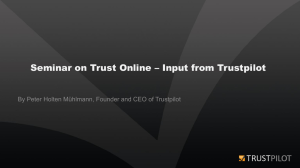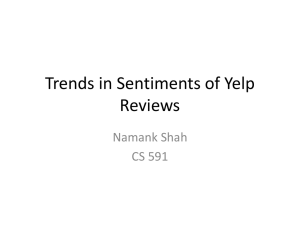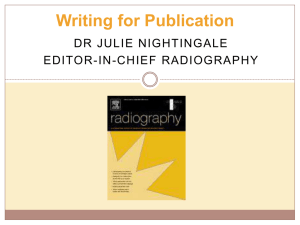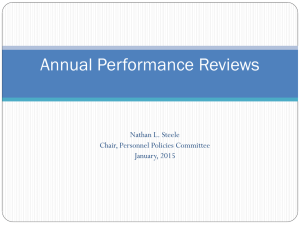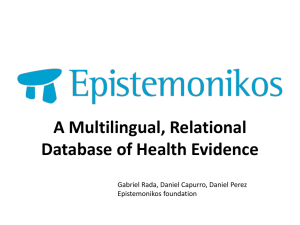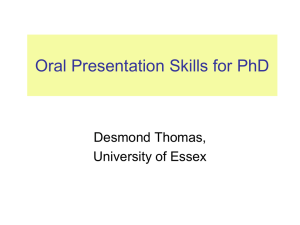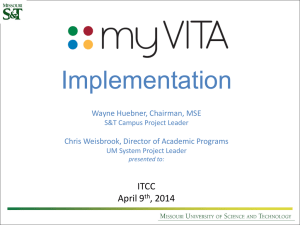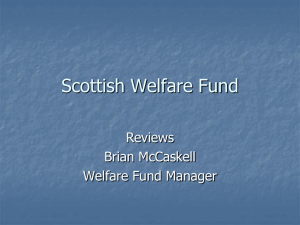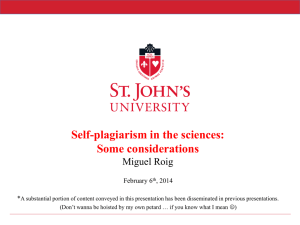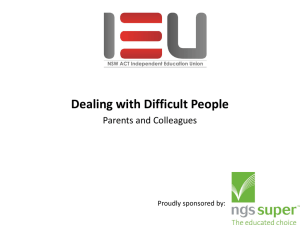Secrets of Publishing in International Journals.ppt
advertisement
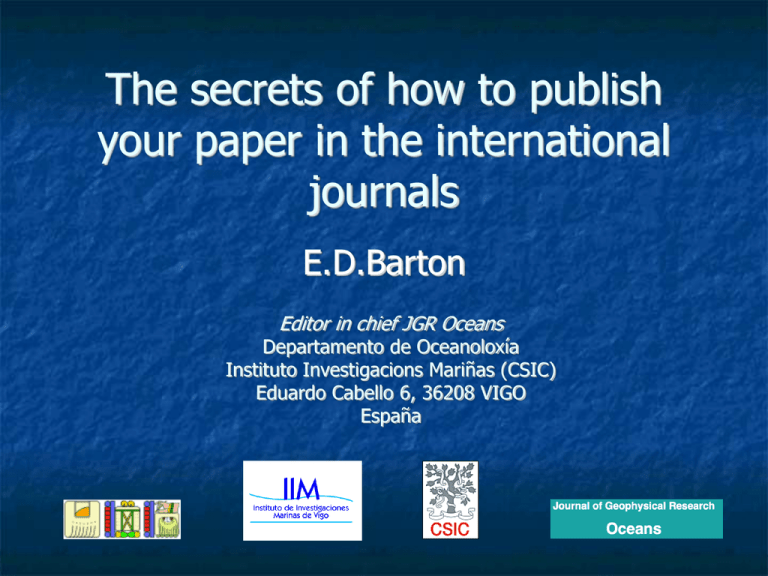
The secrets of how to publish your paper in the international journals E.D.Barton Editor in chief JGR Oceans Departamento de Oceanoloxía Instituto Investigacions Mariñas (CSIC) Eduardo Cabello 6, 36208 VIGO España Outline The road to publication Preparing your paper Common pitfalls Writing in English as a foreign language Plagiarism, self-plagiarism, and dual publication Dealing with reviews Reviewing aids writing Maximising your citations The road to publication Publication 55% Copy editing & production Reviews & editorial decision Select 3 reviewers Editor/AE Scope/Cross check? EiC AGU Quality control <5% Submit ms Base camp –the results >40% Preparing your paper – What makes a good paper? Every paper must have at least one clear key idea that advances knowledge. Papers may be descriptive approaches to phenomena and processes, or purely modeling or analytical treatments. Trend is to combined approaches and to trans-disciplinary analyses. A JGR paper is of more than local interest. Most studies take place in a particular location, but they are publishable when the results and conclusions have a wider importance in terms of processes or dynamics etc applicable to other regions. JGR-C embraces the application of physics, chemistry, biology, and geology to the study of the oceans and their interaction with other components of the Earth system. Deepening the integrated knowledge of the sea utilizes new observational, analytical, computational and modeling capabilities to build upon established approaches in all areas of marine science. Preparing your paper – Structure Follow a standard pattern: •Abstract •Introduction •Methods •Results •Discussion •Conclusions Use formal scientific style. Use a short, pithy title that reflects the main conclusion. Abstracts should summarize the article briefly: •Include motivation, what was done, how, what was found, and major conclusions; •Avoid abbreviations and references, unless absolutely necessary; •Keep it short <250 words in one paragraph. The article should tell a story, set out to lead from one section to the next. Preparing your paper –- Format Preparing your paper - Grammar Grammar and punctuation are important because they are fundamental to transmission of meaning. Poor grammar, spelling and punctuation: lead to misinterpretations and ambiguities; give the impression of lack of care in preparation; suggest perhaps other aspects of the paper are careless; can upset some referees and make them more critical than otherwise; can be difficult to overcome, but it is essential to do so. Preparing your paper - Grammar Be sure to: write complete sentences, not too long, not too short, use commas properly, be consistent in the use of tenses, avoid slang, colloquialisms and jargon, use no contractions – “don’t, couldn’t”, write in reasonably sized paragraphs. Preparing your paper - Grammar A few words on tenses: • when describing the details of an experiment (i.e., what was done), use the past tense - “Velocity was measured with … “; • general truths are expressed in the present – “Velocity is difficult to measure precisely…”, as are conclusions – “In the MCC, maximum velocity coincides with…”; • recommendations often use future tense – “Modeling this velocity structure will require…” A word on voice or mood: though the passive has been preferred in scientific prose, the active voice is more vibrant, often briefer and should be used to highlight important facts and to provide variety. Avoid writing in the first person – repeated use of “I/we” can read as pompous and tiresome. Preparing your paper - Clarity To convey unambiguous meaning: write as simply as possible, use the correct words and terminology, avoid padding “It is noteworthy that in this example…”, delete meaningless or weak words – very, quite, shows, possibly, ensure that pronouns “it, this, those etc” are unambiguous, be consistent in the use of tenses, use “significant” only in its statistical sense, write in reasonably sized paragraphs. Common pitfalls: Wrong journal Dual publication Bad preparation of ms Weakly presented science Incremental advance (< 1 lpu) Localism Lack of discussion Insignificant conclusions Poor response to reviews Despite pitfalls, publication is possible: “There seems to be no study too fragmented, no hypothesis too trivial, no literature too biased or too egotistical, no design too warped, no methodology too bungled, no presentation of results too inaccurate, too obscure, and too contradictory, no analysis too selfserving, no argument too self-circular, no conclusions too trifling or too unjustified, and no grammar or syntax too offensive for a paper to end up in print.” D.Rennie, deputy editor Journal of the American Medical Association Also see: www.ease.org.uk Writing in English as a foreign language W.Strunk and E.B.White The Elements of Style “Vigorous writing is concise. A sentence should contain no unnecessary words, a paragraph no unnecessary sentences, for the same reason that a drawing should have no unnecessary lines and a machine no unnecessary parts. This requires not that the writer make all his sentences short, or that he avoid all detail and treat his subjects only in outline, but that every word tell.” While the book has been criticized by linguistic experts of English language as backward looking, inconsistent , eccentric and overly prescriptive, it remains an excellent guide to anyone who aspires to write elegant, terse, and lively text. Writing in English as a foreign language Points to be aware of include: use “the” and “a” properly and know when to omit them, Current have improved in reliability. choosemeters the appropriate preposition, (general reference) Difficult because both foreign and English prepositions have multiple meanings The current meters were deployed at sites… (the specific ones used) ensure all sentences have a subject, and idiomatic uses: A current meterand was lost at site that…”, A… (an unspecified one) make subject agree, Avoid structures likeverb “Is known not permissible in English – “It is known E.g. “Throughout the summer” not “along the summer” that …” One current meter andwith one many salinometer wereclauses, deployed. (Plural subject The new current meter was lost atsubsidiary site A… (the particular one) and verb) avoid long sentences “For this reason” not “By this reason” One of up theparagraphs current meters deployed. (single subject and verb) break into was digestible lengths, if you are not sure your English is good enough, find a native English speaker to polish the final text. educated Plagiarism, self-plagiarism and dual publication Definition of PLAGIARIZE transitive verb : to steal and pass off (the ideas or words of another) as one's own : use (another's production) without crediting the source intransitive verb : to commit literary theft : present as new and original an idea or product derived from an existing source Copying (or modifying) ideas, text, tables or figures from any source without explicitly acknowledging that source, deliberate or not, is plagiarism. Repeating ideas, text, tables or figures from your own published work without citing the source is self-plagiarism. To avoid plagiarism, always cite your sources for paraphrased passages and place exact quotes inside quotation marks. Copied figures should cite the source in the legend (and may need copyright permissions). Plagiarism, selfplagiarism and dual publication Plagiarism, self-plagiarism and dual publication The above example would be detected immediately by the present QC. CrossCheck provides a summary % of copied text and, for any copied passage of more than a few words, a link to the source document. As a general rule do not copy or paraphrase more than 250 words from any source. Do not re-use published figures. Exceptions: location maps for field work that gives rise to several papers; Methodologies with identical instrumental set up in various studies; introductory passages in related papers from a single study. Reasonable re-use as above is permissible, but it is always advisable to refer to the first of the publications. Plagiarism, self-plagiarism and dual publication AGU policy "prohibits the submission of material for publication that has been previously published in peer-reviewed scientific publication. " EGU states Discussions papers "do not constitute peer-reviewed publications. After interactive public discussion, it appears thus not inappropriate to submit the same manuscript or an improved version for peer-reviewed final publication elsewhere." Authors are therefore justifiably confident that a rejected Discussions paper may be sent to another journal, even though the original remains on the web. However, it seems clear that the availability of two publicly accessible, citable documents with identical titles and similar content by the same authors constitutes de facto dual publication. For this reason AGU considers that Discussions papers and related comments indeed are equivalent to peer-reviewed publications. The consensus at this time is that we should not accept such papers. Dealing with reviews Peer review (PR) is a check on quality basic to modern science, but of relatively recent implementation despite origin in C17. Subject academic work to scrutiny of experts in the field before publication Idea is to improve quality of reports, remove errors, eradicate irrelevancies, & unjustified inferences, unsupported conclusions, avoid personal views But it might allow: maintenance of elites, perpetuation of dogma, obstruction of new findings, personal bias since reviewers principally “established”... The third reviewer Dealing with reviews – the Einstein way: Einstein famously wrote in response to the review of a paper on gravitational waves, submitted to Physical Review: Dear Sir, We (Mr. Rosen and I) had sent you our manuscript for publication and had not authorized you to show it to specialists before it is printed. I see no reason to address the—in any case erroneous—comments of your anonymous expert. On the basis of this incident I prefer to publish the paper elsewhere. Stupid referee, as so often is the case! Respectfully, In fact the referee’s criticism was correct. Einstein later recognized the error and the paper was published elsewhere with a different conclusion. Dealing with reviews Authors can influence outcome of reviews favourably by suggesting lists of suitable and unsuitable reviewers. Not necessarily because of cronyism; could be that authors know who is most appropiate to judge the research. Based on 788 reviews in 10 journals with and without author selection. Few suggestions received for exclusion in JGR. Grimm (2005) Science 309, p1974 Dealing with reviews Do not engage in polemics even with hostile reviews Respond thoughtfully and courteously to the criticisms Answer ALL the points thoroughly If you disagree, explain exactly why in a polite and detailed manner Papers can be rejected because authors do not respond properly to criticism Understand what the decision categories mean before responding Dealing with reviews Accept without revision – very rare for a first submission, but attainable after one or more revisions. Minor revisions – no serious problems with the paper, but points of detail and inaccuracies that require attention. 21 days. Major revisions – paper may be ultimately acceptable but there are some significant problems that imply further or re-analysis, re-writing, changes to figures, additions or deletions etc. 42 days. Reject with encouragement to resubmit – ms looks promising but has sufficient deficiencies that rethinking and complete formulation required; OR Authors have ignored or responded inadequately to repeated major criticisms. Indefinite. Reject – paper inappropriate to journal or is inadequate. Editors can reject without review. Never. Dealing with reviews •Quote and respond to every comment, indicating you agree or disagree with the criticism. Unless the criticisms are exclusively minor points of spelling or similar, replies like “we have corrected the text following the reviewers’ comments” are insufficient in themselves. Reviewers and editor need to see original comment, your reaction, and the changed text or figure together. •Justify any disagreement with any aspect of reviewers’ recommendations. Lay out your reasoning clearly and courteously. Sometimes an apparently major criticism arises because an explanation was ambiguous and misconstrued. If so, clarify the text. •Always incorporate your responses to reviewers’ comments and criticisms into the revised manuscript. Ensure that changes indicated in your response have been made in the paper. They will be checked by reviewers and editor. It is generally a waste of time producing extended text and additional figures solely to explain a point to reviewers. If the point is so complicated, the explanation should be in the paper. Dealing with reviews Ledbetter vs Goodyear Tire & Rubber Following introduction in 2001 of double-blind review by Behavioral Ecology, there was 7.9% increase in female first-author papers. Should female authors use only initials? Budden et al (2007) TRENDS in Ecology and Evolution, 23, 1, 4-6 Results unsupported by further research. Women more often than men lack resources necessary to produce high-quality work. Ceci & Williams (2011) PNAS 108(8): 3157–3162. Dealing with reviews “We portray peer review to the public as a quasi-sacred process that helps to make science our most objective truth teller. But we know that the system of peer review is biased, unjust, unaccountable, incomplete, easily fixed, often insulting, usually ignorant, occasionally foolish, and frequently wrong.” R. Horton, editor of The Lancet On the other hand, no one has suggested anything better and it is demonstrably superior to tradition, received authority, revelation and intuition as a means of approximating “truth”. Options like open reviewing and double blind reviewing are being explored but as yet do not appear convincingly superior. See academia.edu researchgate.net etc. With the move to Open Source publishing, there will undoubtedly be changes. Dealing with reviewers The Editors’ Hate scale for reviewers who say You know where you fit! I personally am Impressed by the diligence shown by some reviewers and Dismayed by the number of invitees who deign not to reply Reviewing aids writing Reviewing develops your critical skills. You see and learn from the common mistakes. You learn what the journal requires of author responses to criticism. You become aware of the need for attention to detail. You recognize the typical problems with figures. You appreciate more the importance of the abstract. You see the latest advances before others. Your opinion influences the science. Be a conscientious reviewer! It is time well spent that will benefit your writing. Unofficial reviews On the internet everyone can be an expert and every opinion is regarded as valid. Any result that attracts public attention or affects vested interests may provoke comment by tweets or blogs. Nu-uh Some guy on Twitter just said you’re wrong Comment may range from wellinformed to idiotic, and can be polite or hostile. Only possible response is courteous and reasoned argumentation of the case. Ensure your results and conclusions are correct and logically justified. Maximising your citations Readers no longer skim journal contents lists. They use internet searches Search engine robots search for KEY WORDS Include them in your title, repeat them in the abstract, and in section headings, all in as natural a way as possible. Check the popularity of key words with Google, but beware that the most searched terms will throw up most competitors, while specific long-tailed keywords may find your interest group more efficiently. Also, cite your related publications and those that cite your work. However, Higgs’ 3170 cites for his 1964 boson paper did not use these means. ISI stats show 47% of all papers are never cited. Remember Sturgeon’s Law! Summary There are no secrets. The necessary information is all freely available. Read the manual before writing! The pitfalls on the road to publication can be overcome by careful preparation and attention to detail. Courteous, considered and detailed responses to the reviews are essential. We should recognize our reviewing debt to the community. For every paper published we owe at least two. We should be diligent and timely in returning our reviews. Though peer review can be robustly criticized as inadequate, it is still the best we have, and should be supported while improvements are sought. In this age of instant communication, “unofficial” or uncontrolled review and criticism of controversial results will inevitably occur outside the learned bodies and journals. Science stands or falls on its reproducibility, openness and honesty and so these developments should be accepted and welcomed. Thank you!
